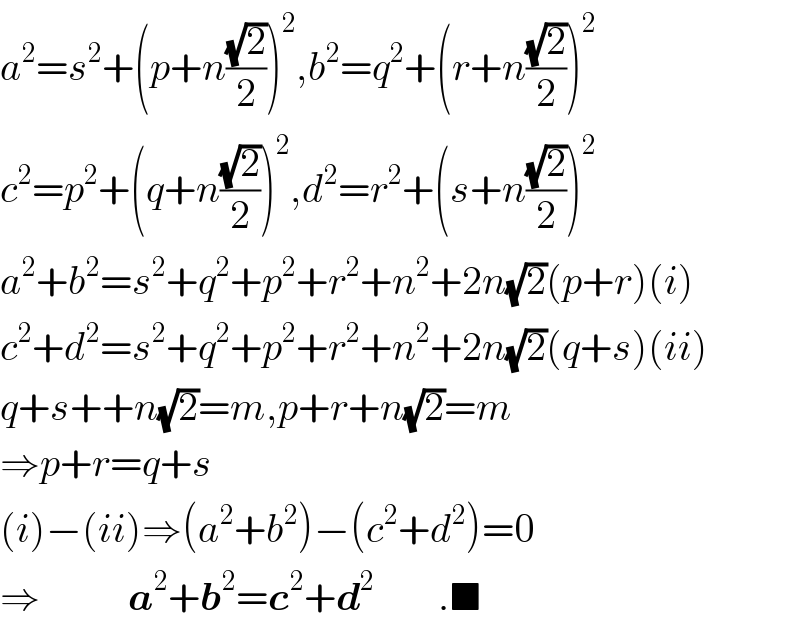
Question and Answers Forum
Question Number 15567 by b.e.h.i.8.3.4.1.7@gmail.com last updated on 11/Jun/17

Commented by b.e.h.i.8.3.4.1.7@gmail.com last updated on 11/Jun/17

Commented by b.e.h.i.8.3.4.1.7@gmail.com last updated on 13/Jun/17

Commented by b.e.h.i.8.3.4.1.7@gmail.com last updated on 13/Jun/17

Answered by ajfour last updated on 12/Jun/17

Commented by ajfour last updated on 12/Jun/17
![let scos θ=s_x , ssin θ=s_y l is the side of biggest square all components of lengths a, b, c, d, and s are positive. from figure above, c_x =b_x +s_y ; c_y =a_y −s_y d_x =a_x +s_y ; d_y =b_y −s_y c^2 +d^2 =c_x ^2 +c_y ^2 +d_x ^2 +d_y ^2 =(b_x +s_y )^2 +(a_y −s_y )^2 +(a_x +s_y )^2 +(b_y −s_y )^2 = (a_x ^2 +a_y ^2 )+(b_x ^2 +b_y ^2 )+4s_y ^2 +2s_y [(a_x +b_x )−(a_y +b_y )] Now (a_x +b_x )=l−(s_x +s_y ) and (a_y +b_y )=l−(s_x −s_y ) ⇒ (a_x +b_x )−(a_y +b_y )= −2s_y continuing, we have c^2 +d^2 = a^2 +b^2 +4s_y ^2 +2s_y (−2s_y ) or c^2 +d^2 = a^2 +b^2 .](Q15626.png)
Commented by b.e.h.i.8.3.4.1.7@gmail.com last updated on 12/Jun/17

Commented by ajfour last updated on 12/Jun/17

Answered by ajfour last updated on 12/Jun/17

Commented by ajfour last updated on 12/Jun/17

Commented by b.e.h.i.8.3.4.1.7@gmail.com last updated on 12/Jun/17

